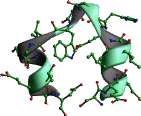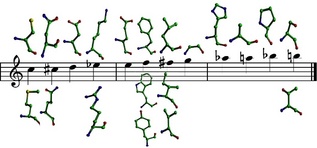Proteomusic
Twisted music inspired by genomes and proteomes
ACGT <-> ACDEFGHIKLMNPQRSTVWY <-> ABCDEFG
Twisted Music Player
This is not pop music. It is a full integration of science and
music ("scimusic" or "muscience", take your pick). It is beautiful
biological atonality created by considering interactions of all the
atoms in a system, i.e., more than just taking strings representing
protein sequences and assigning them to notes. Later compositions will
highlight how the songs are built up but the initial ones are
presented in their full lush complexity, which may makes it hard to
figure out what's going on beyond the wall of sound. To do this, one
can wait for the compositions that showcase the song buildup or, for
now, load the MIDI files into a (computer or other) sequencer and
create and listen to your own (minimalist and varied) mixes.
The beauty of what we're doing
isn't just making and playing programmatic music but that we're giving
people the opportunity who cannot visually see protein structures hear
it in exquisite detail (which may be further improved by the
manipulation of the MIDI files provided, or by playing with the structure_to_music
program in the RAMP software suite under "Music related programs"
(without necessarily needing to recompile). The rough version of the patterns (codes) I've
used is available and visually depicted below.
The songs are listed below with a brief comment regarding the
composition. Clicking on, or selecting, the name of a song will take
you to the song with the coordinates (the "lyrics"), and the
opportunity to hear the sound in stereo MPEG1 Layer 3 (mp3) format
(approximately one MB/minute). You can also download the song in MIDI
and play around with tracks and mixes as you wish, change patches,
soundfonts, effects, and so on, with a software or hardware sequencer
(like a digital piano or keyboard). This means that the MIDI sounds
are likely to come out of your computer which typically aere worse
sounding than sophisticated synthesisers and drum modules. But if you
find an arrangemnt that you would like, I'd be happy to process the
MIDI file through our sounds.
- translation (1ctf - 68 residues - 1:07)
- Translation is the process describing how proteins are made, where
messenger RNA transcribed from DNA are translated by the ribosome
using the genetic code to make chains of amino acids. Musically, this
track represents the C terminal domain of the L7/L12 ribosomal protein
from E. coli solved by M. Leijonmarck and M. Liljas (PDB
identifier 1ctf). In
my early structure prediction
research, this was one of the first proteins I used to debug my
software. It's a small 68 residue protein with both helix and
strand secondary structure (listen to the beat variation -- helices
are the fastest, strands are the slowest, and coil is in between).
This is presented "as is" using the default
chromatic scale note assignment.
- design (1qys-A - 92 residues - 1:30)
- Design is a process where scientists are able to design novel folds
with properties not observed in nature. This particular design track
pays homage to the top7 protein designed by David Baker's group at the
University of Washington. David and his group have generated a
completely novel fold (not osberved in nature) and that is extremely
stable lika rock. This is the first time a design of this calibre has
been accomplished which is why I selected it for this track. I
processed top7 (PDB identifier 1qys-A)
through my structure_to_midi
program for my proteomusic album, then ran
the MIDI signal from my iMac to new Yahama DTX 900 drum module. It
contains some amazing drum sounds and a GM set made up from the Yamaha
Motif samples which are considered state of the art. It's an all
digital recording (transferring data from USB back and forth, amazing
how that technology works). Musically, this track represents the top7
synthetic protein designed by David Baker's group and solved by
Kuhlman B, Dantas G. Ireton GC, Varani G, Stoddard BL, Baker D (PDB
identifier 1qys-A).
This is presented "as is" using the default
chromatic scale note assignment. The only change betewen the translation track and this design track is
the use of different electronic modules to generate the sounds. I have a bunch of observations about
how this novel designed protein is different sounding from naturally
occuring proteins, and also provide additional music that compare and
contrast the two sound modules I'm using, for further exploration.
- twisted helices (th - 20 residues - 0:15)
- Twisted helices is a name for any weird looking helix-turn-helix
protein structural motif. Musically, this track represents the short
protein sequence and structure used to generate the TWISTED HELICES logo. It
essentially contains the amino acids from the name plus some glycine
spacers to display the side chains aesthetically. It was derived from
a helix-turn-helix (ergo, twisted helices) motif in leghaemoglobin
protein (PDB identifier 2lh4). This
is presented "as is" using the default
chromatic scale note assignment.
This work is released in accordance with the Free Music
Philosophy; there is no abridgement on your freedom to copy,
modify, distribute, and use this work, for any purpose (commercial or
noncommercial).
All programming by Ram. All songs were recorded, mixed, and
produced by Ram. Graphics and design on this page and on the album
also by Ram. Read the history for more
information on the software as well as ways to listen to any protein
structure in the Protein Data Bank. Thanks to Jeremy and CompBio.
This album is dedicated to my family: Mali, Aphiwat, Uma (who
particularly was helpful with her honest criticism), and Maya (who was
simply honest).
TWISTED HELICES ||
Ram Samudrala ||
ram@twisted-helices.com





